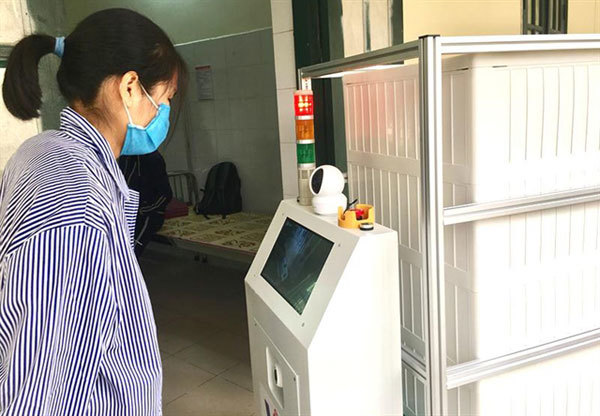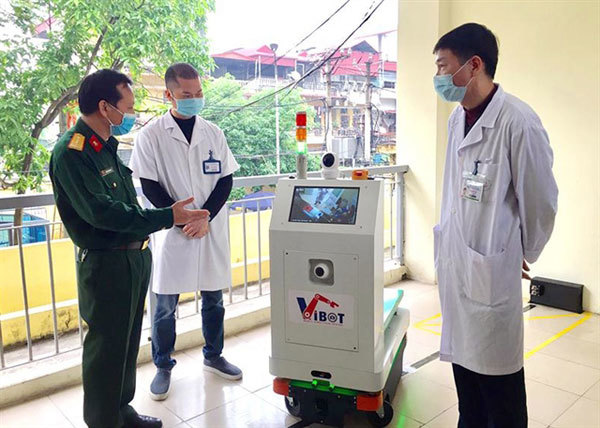
The Ministry of Science and Technology's Military Medical Academy has successfully manufactured a robot that can support healthcare workers caring for COVID-19 patients.
The Ministry of Science and Technology’s Military Medical Academy has successfully manufactured a robot that can support healthcare workers caring for COVID-19 patients.
 |
| A representative of the Military Technical Academy introduces the Vibot Version 1a (Vibot-1a) robot to doctors at Hanoi’s Bac Thang Long Hospital. |
The robot, called Vibot Version 1a, can carry up to 100kg of food, medicine and necessities to COVID-19 patients.
The robot was put on trial on April 7 at Hanoi’s Bac Thang Long Hospital, which has become a quarantine zone for infected patients.
Major General Nguyen Lac Hong, deputy director of the academy, spoke with Vietnam News Agency about the project.
How do you evaluate the use of Vibot Version 1a (Vibot-1a) at high-risk infection areas to minimise the possible spread of the pandemic?
The Military Medical Academy was assigned to manufacture robots to work in high-risk infection areas when the COVID-19 epidemic started to become more complicated.
Vibot-1a has a flexible design to meet the specialised needs of quarantine areas, and can up to 100kg. It can deliver food, medicine and necessities to COVID-19 patients, and remove medical waste and dirty clothes.
The robot can play music and entertainment news, say thank you and wish patients a quick recovery. It can deliver voice and video messages with excellent quality to help physicians talk to patients, and give them advice and encouragement.
 |
| A patient interacts with a doctor via the robot. |
The robots can work in groups or in isolated areas to replace or support health workers caring for COVID-19 patients.
A special feature of Vibot-1a is that doctors can interact with patients with high image and sound quality through a camera mounted on the robot.
As a result, it helps reduce the risk of infection and creates conditions for doctors to focus their time and effort on critically ill patients. It can replace three or five health workers.
Vibot-1a uses magnetic strip navigation technology and a highly reliable identification card that allows it to move around in quarantine areas to perform its tasks.
It is also capable of detecting and avoiding obstacles thanks to sensors fitted in its front and rear. With a large capacity battery and automatic charging station, Vibot-1a can work continuously for 12 hours and automatically returns to the station to charge when it is running out of power.
On April 7, a team of experts from the Ministry of Science and Technology held a meeting for the trial operation of Vibot-1a and recommended the Ministry of Health use the robot in quarantine facilities.
Could you assess the capacity of producing and supplying Vibot-1a to hospitals?
The research team at the Military Technical Academy has experience in designing and manufacturing robots.
Apart from military products, there are other types of civilian robots such as freight robots in warehouses and intelligent robots that support teaching.
In the process of designing and manufacturing Vibot-1a, the academy has collaborated with relevant units to complete it.
In particular, these units have prepared for the production of robots in large numbers within a week to promptly respond to hospitals and isolation areas when required.
I think this is an important and significant success.
Could you tell us more about further research on the project?
The project is divided into two phases.
In the first phase, we focused on manufacturing robots to serve quarantine areas. Vibot-1a has been successfully built with features that meet the specialised needs of each isolation area.
In the second phase, we will continue manufacturing intelligent robots that can build their own operation maps. Later, the robots will work in groups and interact with each other without depending on the control centre.
Currently, we are upgrading the robot’s features so that it can operate automatically and in a smarter way like the TUG robots made by Aethon in the US.
(Source: VNS)





